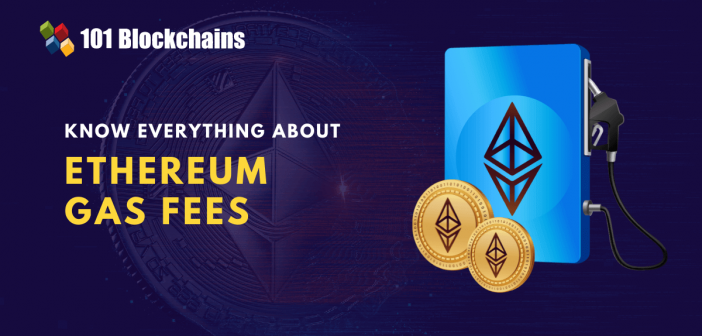Learn how blockchain truly works, master key definitions, and uncover what makes smart contracts so "smart." Dive into the fundamentals, gain valuable insights, and start your blockchain journey today!

- Ethereum
Georgia Weston
- on January 13, 2022
What Are Ethereum Gas Fees and How to Reduce it?
Worried about the increasing price of Ethereum gas? Here’s what are Ethereum gas fees and some top tricks to reduce the fees of Ethereum gas.
Ethereum is one of the common names you must have witnessed while navigating the domain of blockchain technology. As one of the world’s popular blockchain networks, Ethereum provides the ideal foundation for developing smart contracts, and decentralized apps and driving the growth of decentralized finance. With the continuously escalating attention on Ethereum, people are interested in learning more about the network.
If you are a beginner in Ethereum, then you should develop a comprehensive awareness of important topics like Ethereum gas fees. Many of you would be quick to think of the possible reasons to pay for gas on a blockchain network. However, gas fees aren’t anywhere near such assumptions. The following discussion will help you find the answer to “What are gas fees for Ethereum?” and how to reduce the gas fees.
Excited to build your skill in Ethereum development by leveraging the ethers.js library? Enroll Now in Ethers.Js Blockchain Developer Course
What are the Ethereum Gas Fees?
One of the basic tenets of blockchain would obviously refer to consensus, which ensures that all participants in the network agree on a specific state of the network. In the Proof of Stake consensus algorithms, miners use their computational resources for solving mathematical puzzles. The first miner to solve the puzzle would get the privilege of adding transactions in a block.
So, what do the miners get in return for investing their computational resources in adding the transaction of users? The answer would lead you to Ethereum gas fees, which are basically the transaction fees paid to miners. Users have to pay gas fees to miners on a blockchain protocol for including their transactions in the block.
Interestingly, an Ethereum gas fees calculator depends considerably on a standard supply and demand equation. In the event of increased demand for transactions, miners could opt for the inclusion of transactions with higher gas fees. As a result, users would have to pay more gas fees for faster and efficient transaction processing.
Want to learn the basic and advanced concepts of Ethereum? Enroll Now in Ethereum Development Fundamentals Course
How to Find Ethereum Gas Fees?
Apart from the implications of supply and demand for determining Ethereum gas fees, you should also know the specifics of finding out gas fees. Interestingly, one should identify the factors that determine the Ethereum gas cost before finding out how to calculate gas fees. Miners use the following factors for setting the cost of gas fees.
- Existing demand for gas
- Computational resources or power required for processing smart contracts
- Total number of transactions
- Size of the smart contract which has to be executed
You can find productive methods to reduce Ethereum gas fees once you are capable of understanding gas fees on a fundamental level. One could think of gas as a fundamental element in the Ethereum network. If you narrow it down further, gas is basically the unit of measurement for tracking the cost of executing computation for a particular task on Ethereum.
What is the basic reason behind the concept of gas fees? The primary objective of gas fees focuses on ensuring effective operations of the Ethereum network. Ethereum gas fees help in paying miners for their work in securing the network as well as preventing spam transactions.
Excited to learn the basic and advanced concepts of ethereum technology? Enroll Now in the Ethereum Technology Course
Gas Limit
Gas provides a fundamental instrument for accessing decentralized computation on Ethereum. Denoted as gwei, one gas unit is equal to 0.000000001 ETH. So, if you find that gas is 50, then the estimated cost for completing an Ethereum transaction would be somewhat near 50 gwei. However, you should not calculate the gas fees by following a similar approach.
On the contrary, you need to consider the implications of the gas limit on Ethereum for calculating gas fees. As of now, the gas limit of Ethereum is almost 15 million units, which indicates the number of gas users can spend in an Ethereum block. In addition, it is also important to note that an Ethereum gas fees calculator would also impose specific gas limits for particular types of transactions. For example, the gas limit for a basic ETH transfer is around 21,000 units.
You can calculate Ethereum gas fees by multiplying the gas limit of a transaction with the existing gwei price. For example, you can calculate gas fees like the following.
21,000 gas limit * 0.000000001 ETH * 50 gwei = 0.00105 ETH.
Reasons for the Increasing Cost of Gas Fees
One of the first reasons to find out how to reduce Ethereum gas fees is the continuously increasing gas fees. The obvious reason for increasing gas fees is the radically escalating use of the Ethereum blockchain. Ethereum gas fees have reached staggeringly peak levels during eventful scenarios such as the ICO boom of 2017 and, most recently, the DeFi revolution.
If you take the case of DeFi, Ethereum has emerged as a promising platform for developing DeFi solutions. Furthermore, the real use cases of Ethereum and its use in developing decentralized applications or dApps also burden the network. As a result, the increasing load on the Ethereum blockchain has translated effectively into massive growth in gas fees.
Want to learn and understand the scope and purpose of DeFi? Enroll Now in DeFi Introduction Course
Methods for Reducing Ethereum Gas Fees

Please include attribution to 101blockchains.com with this graphic. <a href='https://101blockchains.com/blockchain-infographics/'> <img src='https://101blockchains.com/wp-content/uploads/2022/01/Methods-for-Reducing-Ethereum-Gas-Fees.png' alt='Methods for Reducing Ethereum Gas Fees='0' /> </a>
As you can notice clearly, the recognition of DeFi solutions and the role of Ethereum in the DeFi revolution plays a huge role in escalating gas fees. The growing levels of DeFi activity create the need for paying higher gas fees to miners. Therefore, the use of decentralized applications turns out to be economically unfeasible for regular users.
For example, the cost for a simple token transfer reaches around $67. While Ethereum plans to move towards the Proof of Stake consensus protocol in the near future, it is important to find ways to reduce Ethereum gas fees right now. Here are some of the promising ideas that you can use to reduce gas fees without compromising on transaction processing.
Want to explore in-depth about DeFi protocol and its use cases? Enroll Now in Decentralized Finance (Defi) Intermediate Level Course
-
Capitalize On the Value of Simulation
The foremost initiative for supporting the reduction of Ethereum gas fees would point out towards the best use of simulation. It is impossible to find the actual gas fees until you execute a transaction to pay for the gas fees. On the contrary, you could use simulation tools such as DeFi Saver for simulating your transactions.
All you have to do is create recipes for Ethereum transactions and ensure their virtual execution. The simulation could easily help you figure out the estimated gas fees and the maximum limit in ETH. Users could customize the whole recipe for minimizing the gas fee and execute it on Ethereum in real.
-
Classify the Transaction Types
The next promising recommendation on how to reduce Ethereum gas fees would refer directly to the classification of transaction types. You should remember that the gas fees differ according to the types of transactions on Ethereum. So, you should try to classify similar transactions and execute them together to save gas fees.
For example, just assume that you have two distinct Ethereum addresses with 1000 tokens in each account. Now, you have planned to lock all the tokens in a vault of a new decentralized app. What can you do to reduce Ethereum gas fees in this case? The best answer for this question would basically involve transferring all tokens to one address. Then, you can lock the 2000 tokens in a single transaction and save gas fees.
Start learning about second-most-popular blockchain network, Ethereum with World’s first Ethereum Skill Path with quality resources tailored by industry experts Now!
-
Use Gas Tokens
Another proven measure for reducing gas fees without using an Ethereum gas fees calculator would involve gas tokens. What are gas tokens? Upon deleting the storage variables on the Ethereum network, users can receive refunds in ETH, which serve as foundations of gas tokens.
Interestingly, you could mint a sizeable number of gas tokens in scenarios with extremely low gas fees. You can redeem the gas tokens to obtain ETH at times when you plan the execution of transactions on the network. The redeemed ETH could easily help you reduce Ethereum gas fees without any additional efforts.
-
Keep an Eye on Network Congestion
When the number of transactions increases profoundly on the Ethereum blockchain, your transaction can be put on hold. As the transaction stays on hold, the gas fee continues to increase. So, your proposed gas limit would most probably fall below the existing rate upon starting the execution process. The problem, in this case, would focus on the possible loss of your gas fees for an unfinished transaction.
Therefore, you need to keep an eye on the Ethereum gas fees chart to monitor the trends and plan your moves. The common recommendation would refer to planning your Ethereum transactions around non-peak hours. You can leverage Ethereum gas charts for identifying the live pricing for gas fees according to the local timezone. You can use the chart to obtain an accurate estimate of gas fees alongside setting the perfect gas limit.
Excited to know about how to become an Ethereum developer? Check the quick presentation Now on: How To Become an Ethereum Developer?
-
Choose Solutions with Lower Gas Fees
One of the interesting recommendations for lowing Ethereum gas fees would refer to a newly emerging breed of dApps. Many new Ethereum projects and decentralized applications offer subsidies on a gas fee or lower gas fees in comparison to the market. The best example of such platforms is evident in the case of Balancer. The DeFi solution provides a gas fee refund in the amount of 90% as a BAL token.
In the case of high-frequency traders, Balancer provides a massive reduction in gas fees through executing transactions without exiting the vault. Furthermore, examples of DeFi apps such as Yearn and KeeperDAO showcase the efficient batching of individual user transactions. Users could pay the gas fee in a one-time payment, thereby reducing the gas fees by a considerable margin.
-
Optimize the Transaction Timing
The most favorable instrument for reducing gas fees would obviously bring the Ethereum gas fees chart to notice. Many people would know that network congestion is the primary cause of higher gas fees on Ethereum. On the other hand, the traffic of Ethereum transactions fluctuates in variable margins throughout the day. You could witness lower gas fees for transactions that apparently specified a higher gas fee only a few hours ago.
However, it is quite difficult to round up on the exact time of the day when you could witness such changes. So, you need to leverage the Ethereum Gas Charts to access a detailed graphical representation of gas prices. Another interesting trick to reduce Ethereum gas fees would involve taking a leave from working hours, especially on weekdays. Why? Apparently, the gas prices dip on the weekends, thereby providing an exceptional opportunity for savings.
Curious to know how to build your expertise in Ethereum technology? Check the detailed guide Now on How To Advance Your Ethereum Skills?
Bottom Line
The continuously growing cost of gas fees has become a notable concern in the crypto landscape. Ethereum blockchain provides a solid foundation for DeFi, dApps, and NFTs, which have the potential to redefine the world. Therefore, the increasing demand for transactions on Ethereum with DeFi solutions translates directly into rising Ethereum gas fees.
Although layer 2 scaling solutions and staking consensus might introduce some improvements, the high gas fees are an important concern at present. All you need to do is understand the fundamentals of gas fees and the best practices for reducing them. Most important of all, pay close attention to the pointers for reducing gas fees, and you can implement them easily. Learn more about Ethereum and start exploring new possibilities for reducing gas fees on Ethereum right now.
*Disclaimer: The article should not be taken as, and is not intended to provide any investment advice. Claims made in this article do not constitute investment advice and should not be taken as such. 101 Blockchains shall not be responsible for any loss sustained by any person who relies on this article. Do your own research!





